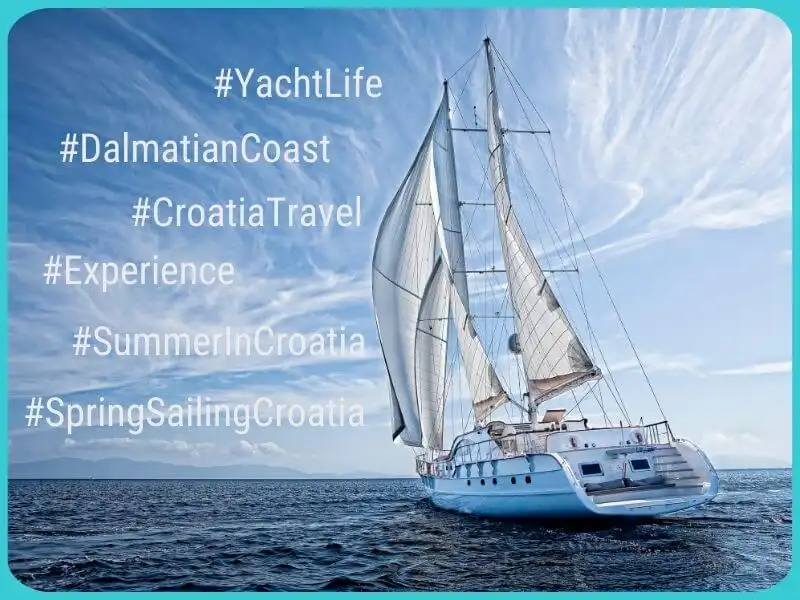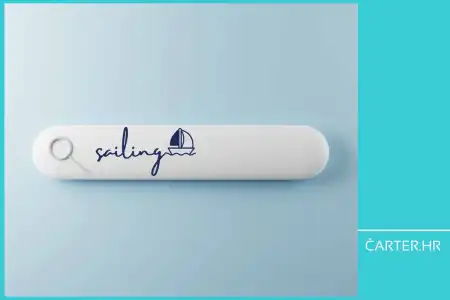
- 11.11.2024.
- News, Marketing, Social media
Social media is constantly evolving, with new trends, tactics, and platform updates coming at you fast. With all these changes, it’s easy to get caught up in misinformation or outdated advice. However, learning to separate fact from fiction is one of the most valuable skills you can develop for long-term success.
Social media isn’t to be looked at as just another tool for you to use.
Social media platforms are the bridge to reaching people.
People who wish to spend a vacation sailing on the Adriatic coast. And those who don’t know this fact yet, i.e., those looking for inspiration.
Yet, social media is filled with myths, and if you don’t use them as they should be used, you can drain your precious time and resources, leading you in circles with little to show.
These myths, if left unchecked, can steer you away from real opportunities, often creating obstacles that simply don’t exist.
Let’s see what are the most widespread social media misconceptions that you should know (and avoid) when managing social media for your yacht charter (and any other) company.

1. More followers, more everything? Quality always trumps quantity.
One of the biggest myths in social media is that more followers equal more success.
That’s simply not true.
While a large number of followers may look impressive, numbers alone don’t guarantee engagement, leads, or bookings.
A yacht charter business with thousands of random (or even bought) followers likely won’t see the same impact as one with a smaller, dedicated audience who actively interacts with content.
Quality followers—those genuinely interested in your brand, location, or services—are more likely to engage, share, and, in the end, convert.
In the end, it’s better to have a smaller crowd of enthusiasts eager to see what you’ll post next, than a huge group with no connection to your offer.
Focus on building a community of loyal followers who value what you offer and engage with your posts. Focus on people who send you their content made while vacationing on your vessels, and share your content with others who may also be genuinely interested.
2. Posting every day? Is it really necessary?
The notion that you must post daily to stay relevant is another myth.
While consistency is important, quality content beats high frequency. And that’s it.
“Attacking” followers with content just because you can or feel that you must, will lead to burnout, both for the audience and for whoever is managing your social media profiles.
Instead, prioritise content that rings true to your followers, such as a breathtaking sunset over the Adriatic, an engaging story about a recent yacht charter experience, or tips on how to explore the Adriatic’s less known locations.
You must also find a schedule that suits your audience’s behavior.
Tools like Meta Business Suite can give you information when your audience is most active.
Aiming for quality over quantity doesn’t mean your presence is diminished; it means each post has purpose, resulting in higher engagement and a more dedicated following.
3. Social media is just for young(er) people? Think again!
There are some who believe that social media is exclusive for young people, that people above a certain age don’t engage in social media—but this myth ignores the platform’s true reach.
The demographics on social media are diverse, covering every age group and interest.
Monthly active users: 3.065 billion
Largest age group: 25-34 (29.9%)
Time spent per day: 30.9 minutes
Monthly active users: 2 billion
Largest age group: 18-24 (30.8%)
Time spent per day: 33.1 minutes
TikTok
Monthly active users: 1.7 billion
Largest age group: 18-24 (36.2%)
Time spent per day: 53.8 minutes
X (formerly Twitter)
Monthly active users: 368 million
Largest age group: 25-34 (38.5%)
Time spent per day: 34.1 minutes
YouTube
Monthly active users: 2.491 billion
Largest age group: 25-34 (21.2%)
Time spent per day: 48.7 minutes
Number of members: 1 billion
Largest age group: 25-34 (60%)
69% of users access the platform daily, and 15% use it several times a week.
Monthly active users: 498 million
Largest age group: 25-34 (30.9%)
Time spent per day: 14.2 minutes
Yacht charters are maybe more often sought out by older audiences with disposable income—and yes, they’re active on platforms like Facebook, Instagram, and even LinkedIn.
Older age groups use social media to research travel options, connect with companies, and find experiences that align with their interests.
How do you make your social media appealing to different age demographics? Make your strategy inclusive.
With this approach, you'll be speaking to a wide range of potential guests while also tailoring content that appeals to varied lifestyles and interests.

4. Visuals are everything—or are they?
Eye-catching visuals are essential for some social media platforms. And even though it is said that a picture is worth a thousand words, relying on photos alone can miss the mark.
Beautiful images can stop someone from scrolling, but captions that engage a person, posts that can educate and be interesting at the same time, and a compelling story can make them stay.
If you share fun historical facts of an Adriatic island, together with a photo of that same island, it will add depth to the image and create a fuller experience.
By pairing visuals with storytelling, you can demonstrate your yacht charter company’s personality and give your audience a taste of what it’s like to sail with you.
Don’t just aim for “likes.” Aim for comments, shares, and real connections with followers.

5. Negative comments? Just delete them? No.
Everyone’s first (and natural) reaction to criticism is to hide it, especially in the public space of social media.
Deleting negative comments only gives the impression that your business is afraid of addressing it. Responding to it is an opportunity to build trust by showing that your company values feedback and is committed to improvement.
One thing you must do is address criticisms with professionalism and empathy. Whether it’s a comment or a question, by handling it publicly, you show transparency and integrity.
And if you see these situations as relationship-building moments... You can make people feel heard and valued.
6. Facebook is outdated. Is it really?
Many consider Facebook to be a platform of the past, but that couldn’t be further from the truth.
Facebook remains (and the statistics show) that Facebook is still one of the most versatile platforms for targeted advertising, group engagement, and building communities.
Facebook’s ads, for example, allow for incredibly specific targeting - you can reach potential guests based on location, age, gender and more.
Beyond ads, Facebook groups and pages can create active communities where past guests and people interested in yacht charters can engage, ask questions, and share their experiences.
For example, a Facebook group for yacht enthusiasts planning an adventure on the Croatian Adriatic could be a perfect space to share first-hand info and connect with potential guests directly.
7. You have to be on every platform. No, you don’t.
It’s tempting to be everywhere, on every social media, to copy-paste posts, to copy-paste pictures...
But managing multiple platforms can stretch your resources (and employees) thin.
Each platform has its own style, audience, and best practices. Instead of trying to maintain (the same) presence on every network, focus on the platforms that align with your audience.
Instagram, with its emphasis on visual content, may be a top choice for yacht charter companies, while LinkedIn can connect with peers, tools, and even competitors.
Choose one or two platforms where your ideal audience is most active and put your energy into making high-quality content there.
This way, you’re saving time and also providing value where it counts.

8. Just boost your posts. It’s a shortcut. It works. - No.
Boosting a post is often seen as a quick way to increase reach. This fact is true.
But it’s not the most effective way to spend your budget.
Boosting is sort of a “light” version of a paid strategy, which is lacking the targeting depth needed for significant engagement or conversion.
Instead, it’s best to invest in paid ads that let you define your target audience, optimise for clicks, or even drive people to book directly through your website.
Use Facebook Ads Manager or Instagram’s advanced targeting to reach people who’ve expressed interest in sailing, yacht charters, or nautical tourism.
With a smarter ad strategy, you’re more likely to see genuine leads and conversions than a quick boost could ever give you.
9. Social media requires a big budget? False.
The truth is, you don’t need a massive budget to succeed on social media. In fact, smaller budgets, when used creatively, can give quite impressive results.
Tools like user-generated content, collaborations, and influencer partnerships can drive engagement at a fraction of the cost of traditional ads.
For example, a partnership with a local travel influencer could introduce your brand to a targeted audience. User-generated content illustrates real experiences without the need for a high production budget.
Even organic posts can perform well with a solid strategy, proving that big budgets aren’t the key to success.
It’s all about making the most of what you have and focusing on content that resonates with your audience.

10. Hashtags don’t work for yacht charters or niche markets? Wrong!
Hashtags can be incredibly effective, especially for niche markets.
Niche hashtags help you reach a smaller but highly relevant audience who may already be interested in booking a yacht charter.
Here are 5 ways to use hashtags for niche markets:
- Combine broad and niche hashtags - mix a few popular, general hashtags like #LuxuryTravel or #TravelInspo with specific ones like #YachtCharterCroatia or #SailWithUsCroatia to boost reach while keeping it relevant.
- Include location-based hashtags - add location-specific tags like #CroatiaTravel, #DalmatianCoast, or #SplitYachtLife to target potential guests specifically interested in your region.
- Create a unique brand hashtag - develop a signature hashtag for your brand, like #YourCompanyNameExperience or #YachtWithYourBrand, and encourage followers to share their experiences and make it easy to find user-generated content.
- Use event or season-specific hashtags - tie into trends or seasons by using hashtags like #SummerInCroatia or #SpringSailingCroatia to connect with followers searching for seasonal experiences.
- Research and rotate hashtags - regularly switch up your hashtags to avoid shadowbanning (when your post visibility is limited due to repetitive hashtag use). Try new combinations and track which ones bring the most engagement.
The secret to hashtags is to find the right balance between reach and relevance. Track the performance of your hashtags and refine them over time to see which works best in attracting engagement.
11. Overnight success? Social media is in it for the long run.
Social media isn’t a shortcut or something to be done seasonally (as many do) - it’s a commitment.
Building a social media presence takes time, consistency, and focus on relationships with your audience.
In the yacht charter business, trust is a main factor, and trust isn’t built overnight. Focus on creating valuable content, responding to enquiries and comments, and showing followers why your yacht charter company is different than others.
Social media also rewards patience. If you focus on creating long-term connections, you’ll attract followers who genuinely believe in you as a brand and look forward to experiencing an adventure with you.

Bonus: How to spot and avoid social media myths in the future
Learning to separate fact from fiction on social media can save you time and resources. Social media isn’t one-size-fits-all, so don’t hesitate to adapt your approach based on real-world results.
Here are some strategies to help you stay on track and avoid social media myths:
1. Stay informed with trusted sources
Social media algorithms, best practices, and platform rules change frequently. Rely on trusted sources like official blogs such as Instagram’s business blog, Social Media Examiner, or HubSpot, and the information shared by industry experts.
2. Follow industry experts
Social media experts frequently share insights, trends, and firsthand experiences that can help you differentiate myths from reality. Following professionals on LinkedIn or their personal blogs can keep you aware of the latest practices, especially for niche markets like yacht charters.
3. Test strategies yourself
No two audiences are exactly the same, so what works for one business might not work for yours. Try varying post formats, ad types, engagement tactics, and hashtags to see what brings the most value to your followers. Track metrics like engagement rate, reach, click-throughs, and conversions to get a true sense of what resonates with your audience.
4. Be wary of trends without evidence
A flashy new tactic or trend might look promising but could end up being a fad that doesn’t resonate with your audience or goals. Before getting into any trend, ask yourself how it aligns with your brand and audience. Look for evidence that it’s worked for businesses similar to yours or test it on a small scale first.
5. Analyse your own data regularly
By analysing data, you’ll see patterns that reveal what works best for your unique audience. Pay attention to which posts generate engagement, what times your followers are most active, and which ads drive conversions.
6. Seek feedback from your audience
Sometimes the best insights come directly from your followers. Don’t hesitate to ask questions, conduct polls, or even message active followers to get their thoughts on what they enjoy about your content. Engaging with your audience directly provides real, actionable feedback, which is more valuable than any trend or myth.
What works well for one on socila media might not for the other. What might work for your yacht charter might not work for your competition, no matter how small and unique your yacht charter niche is.
Our advice is to approach social media like an ongoing experiment - be ready to change direction based on what you learn from your audience.
If you find out something is effective, build on it.
If it doesn’t work, let it go and try something new.
It’s that simple. But you also have to be flexible and adaptable if you want your brand to evolve along with the platform itself.
If you need help letting go of the myths and tall tales and embracing smart strategies, contact us.
You can even send us a message on our social media; Facebook, Instagram nad LinkedIn – but don’t forget to follow us.
And be sure to subscribe to our regular newsletter with fresh and interesting news from the yacht charter industry.
Source: Statista
Categories of trends
- News
- Sale
- Marketing
- SEO
- Web design
- Social media
- Technology
- Regulations
- Management
- Education
- Finances
- User experience
Newsletter
Sign up for the newsletter and receive the latest trends and tips straight to your inbox



